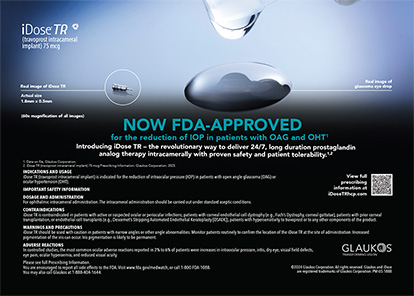In recent editorials, the chief medical editors of Ophthalmology Times (Peter McDonnell, MD), EyeWorld (Stephen Lane, MD), and Ocular Surgery News (Richard Lindstrom, MD) have discussed the role and relevance of their respective publications. I can't help but reflect back to my residency when the “throwaways” were regularly ridiculed during grand rounds. However, thanks to burgeoning information overload, ophthalmologists' needs and the times have changed. Indeed, having the Wilmer Institute Chair become the newest chief medical editor of this genre fittingly culminates a long evolving trend toward the greater influence and credibility of the nonpeer-reviewed ophthalmic monthlies.
I was struck by another signal of the times at the recent AAO meeting in New Orleans. As Chair of the cataract program subcommittee, I was heavily involved with two sessions, the cataract spotlight symposium and the cataract free papers. Of all the major meetings, the AAO's continues to have the most rigorous peer-review system for papers, posters, and instruction courses. Through a painstaking process of masked online grading, conference calls, and meetings, our eight-member subcommittee selected the 10 best cataract free papers from more than 100 abstracts submitted. We chose 10 discussants who carefully reviewed each full manuscript in advance. Finally, we assembled a panel of four cataract experts to make additional comments following each presentation.
Although the free-paper symposium was both interactive and illuminating, I was disappointed that this session attracted only approximately 150 attendees. Several hours earlier, the same cavernous auditorium had been filled with more than 2,000 attendees for the Spotlight on Cataract Controversies symposium. This session featured 32 opinion leaders whose 7-minute presentations on cutting-edge topics reviewed their personal experience, the evidence-based literature, and in many cases, their own clinical studies. Unlike the free papers that were submitted months earlier to accommodate the peer-review process, these talks could incorporate last-minute developments. As such, they were current (timely), concise (summarizing), credible (evidence-based), and clinically relevant (practical).
The reason for such disparate attendance levels was clear: meeting attendees were more interested in hearing well-respected experts summarize relevant studies than they were in listening to the actual scientific papers. These practical overviews must have offered a better educational value for the attendees' precious limited time. I am sure that this phenomenon mirrors the growing difficulty all physicians face of staying abreast of the peer-reviewed journals. Although we clinicians understand that peer-reviewed studies are the foundation of our knowledge, we would love to have a trusted authority review the literature and summarize the bottom-line recommendations for us. Despite significant overlap, the monthly ophthalmic periodicals thrive, undoubtedly for this reason.
Although our articles are not strictly peer-reviewed, John Doane, MD, and I, together with our active editorial board, serve as Cataract & Refractive Surgery Today's “program committee” by selecting editorial topics and authors each month. We personally review every submission and try to enlist differing viewpoints wherever possible.
This month's cover focus on endophthalmitis is an excellent example of the merits of this format. Without prospective, randomized studies, the peer-reviewed literature does not settle the controversies over how best to prevent surgical infection. Therefore, we have convened a group of experts to give us their opinions and recommendations based upon the best clinical and scientific evidence to date. With our rapid publishing rate compared with the peer-reviewed journals' and textbooks', we hope you will find the information to be current, concise, credible, and clinically relevant.


